Do you want to develop an eLearning app?
The market for online education apps is growing like crazy and this has attracted investors and innovators from all across the world.
Curiosity and awe are soon followed by questions.
How do you develop an app? How much does it cost to develop such an app? How long does it take? How can and how much money can I make with it?
This step-by-step guide to develop an eLearning app will answer all of those questions.
So with this being said, let’s get right into it:
Booming eLearning App Market
Planning to develop an education app?
Well, you aren’t the only one. There are other 100 companies, businesses, and startups alike who want to create their own eLearning app.
This begs the question why? Well, the answer is simple.
The edtech market is booming.
- The global eLearning industry is on track to achieve a significant milestone by reaching a valuation of $1 trillion by the year 2032.
- Projected growth in the global corporate eLearning market is expected to result in a total value of $44.6 billion by 2028.
- Over the next few years, the European eLearning market is anticipated to experience a robust expansion, increasing by $147.7 billion between 2021 and 2025.
- The eLearning market in India is forecasted to continue its upward trajectory, reaching a valuation of $8.6 billion by the year 2026.
- In the United States, a substantial majority of students, nearly 75%, have shown a preference for continuing their education through online classes even after the pandemic.
- A significant 36.7% of educational institutions have opted for Instructure’s Canvas as their preferred Learning Management System (LMS).
- An overwhelming 90% of companies now provide some form of digital learning option to their employees.
- Coursera has seen a dramatic increase in its user base, with registered learners growing by 438% over a span of five years.
eLearning Apps – Driving Next Gen Education
So, what are eLearning apps?
Whether you call it an eLearning app, educational app, edtech app, or online learning app, it’s the same.
These are digital platforms that facilitate learning through interactive and accessible formats, often via smartphones, tablets, or web browsers.
Moreover, these applications provide educational content across various subjects and skills, ranging from academic courses to professional training. They typically feature multimedia integration, assessment tools, and personalized learning experiences to enhance user engagement and knowledge retention.
And as for what they do – in layman’s terms – it helps users acquire new skills, basic education, or knowledge in a much easier “online” medium.
Since we are talking about app development, the medium is mobile phones or tablets.
After all, this isn’t a new concept. Everyone has used some of the popular eLearning apps whether it is Duolingo for language learning or Edx for university-level courses.
Speaking of which, this brings us to another major point, the different types of educational apps.
Types of Education Apps
It goes without saying there are various types of eLearning apps.
Each of them is purpose-built to fulfill the needs of their users. We shall be going through the same.
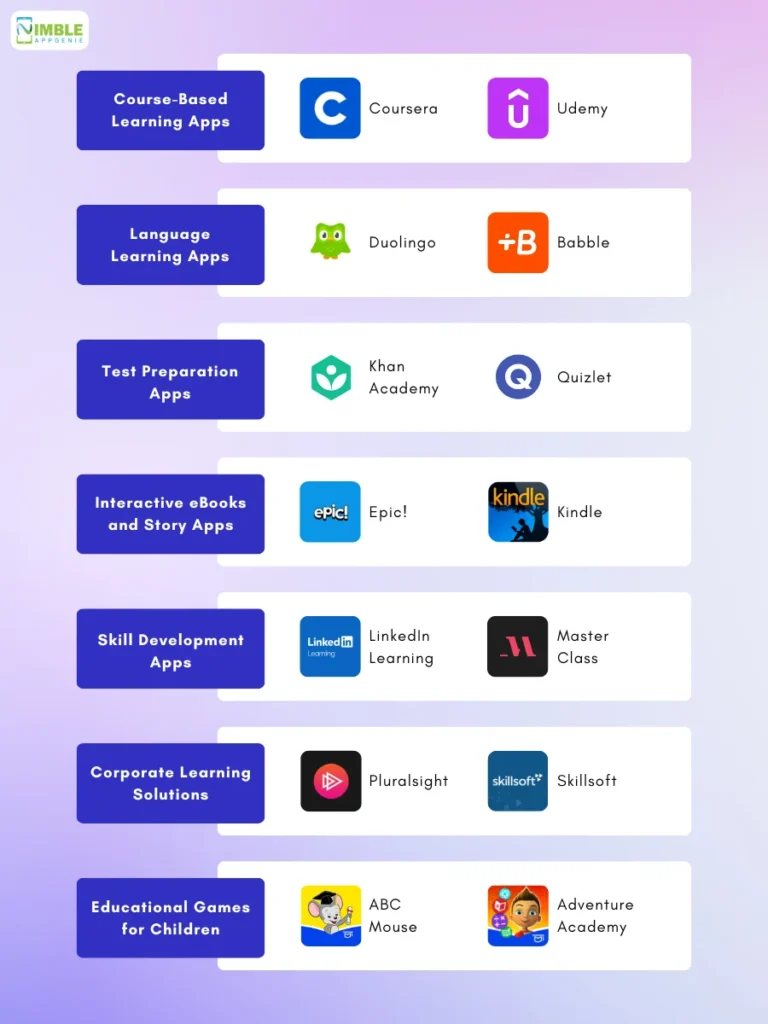
Let’s get right into it, starting with:
Type 1: Course-Based Learning Apps
These apps offer structured course material on a wide range of topics and often come with certifications. They are ideal for users looking to develop an educational app that offers formal education with a curriculum.
Example: Coursera and Udemy, where users can learn anything from computer science to art history and obtain certificates.
Type 2: Language Learning Apps
Language learning apps are growing super popular (not to be confused with language exchange apps)
But what are these?
Language apps focus on helping users learn new languages through interactive lessons and games.
They are a popular choice for those looking to create an educational app that facilitates communication in different languages.
Example: Duolingo and Babbel offer bite-sized lessons for improving language skills effectively.
Type 3: Test Preparation Apps
These apps are designed to help students prepare for specific exams, such as college entrance exams or professional certification tests.
A key market for those aiming to create an online learning app that provides practice tests and study materials.
Example: Khan Academy and Quizlet, which offer extensive resources for a variety of tests.
Type 4: Interactive eBooks and Story Apps
Apps that transform traditional reading experiences into interactive journeys are also a significant part of the education sector.
They are perfect for publishers looking to develop an educational app that merges storytelling with learning opportunities.
That’s what makes eBook app development so popular.
Examples: Epic! and Kindle, which provide interactive books for readers of all ages.
Type 5: Skill Development Apps
Focused on professional and personal development, these apps help users acquire new skills or enhance existing ones. They are particularly valuable for businesses interested in mobile eLearning app solutions targeting adult learners.
Example: LinkedIn Learning and MasterClass, which provide expert-led courses in areas like business, technology, and creative arts.
Type 6: Corporate Learning Solutions
These apps are designed to facilitate continuous professional development and training within a corporate environment.
They help businesses train their employees in specific skills and compliance requirements efficiently.
An essential category for those targeting the professional segment with their eLearning app project efforts.
That’s why so many large corporations invest in LMS development.
Example: Pluralsight and Skillsoft, which offer specialized courses tailored to enhance workforce skills and meet corporate training objectives.
Type 7: Educational Games for Children
These apps combine learning with play, making education enjoyable for children. They focus on basic skills such as math, reading, and science. An excellent focus for those wanting to develop an eLearning app that appeals to young learners.
Example: ABCmouse and Adventure Academy, which offers educational games that captivate and educate children.
With the different types done, let’s move to the next section.
Why Build an eLearning App in 2024?
So, why invest in app development?
Digital transformation has ushered in a new era for education, making the eLearning app project an exciting venture for startups and businesses.
As we delve into the benefits, it becomes evident why entities are eager to create an educational app.
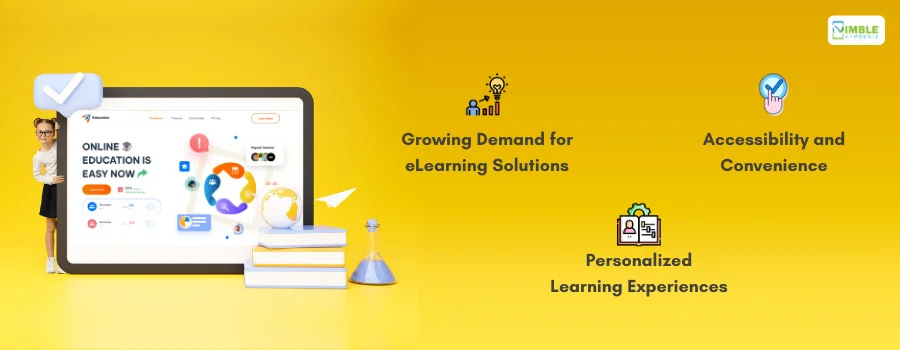
Here are several persuasive reasons to consider this opportunity:
Growing Demand for eLearning Solutions
One of the biggest reasons to develop an educational app is the booming market.
The demand for digital education tools is soaring, with the global eLearning market expected to reach $375 billion by 2026.
This rapid growth signifies a robust opportunity for developers looking to create an online learning app.
Educational apps cater to this burgeoning demand by providing innovative and scalable learning solutions.
So, if you want to become popular among people, this is the right time to invest.
Accessibility and Convenience
One thing we can all agree on is that accessibility and convenience are the core benefits of eLearning apps.
In layman’s terms, we can say that educational apps excel in making learning accessible and convenient for users worldwide.
They eliminate geographical barriers, enabling access to quality education from anywhere at any time.
This feature is particularly appealing to those looking to develop an educational app that empowers users to learn on their terms, enhancing the appeal and utility of mobile eLearning apps.
Personalized Learning Experiences
It goes without saying that the purpose of the edtech platform is to deliver personalized learning.
Unlike traditional education systems, educational apps can offer highly personalized learning experiences, thanks to advancements in data analytics and artificial intelligence.
This capability to tailor content and learning paths to individual needs is a key selling point for entities aiming to develop an eLearning app.
Personalization not only improves engagement but also boosts the overall effectiveness of the learning process.
Learn From the Best – Top eLearning Apps
One of the most important parts of learning How to create an eLearning app is getting inspired.
You see, the market is filled with top eLearning apps. And each of them has something to teach you.
So, let’s start looking at top platforms and what they can teach us:
► Khan Academy (Free Educational Resources)
Khan Academy provides a comprehensive curriculum of high-quality educational resources, completely free for users.
- Lessons for Startups: Khan Academy demonstrates the power of accessibility in education. Consider offering a freemium model with core functionalities available for free, alongside premium features or paid subscriptions for in-depth learning.
► Byju’s (K-12 Learning)
Byju’s leverages interactive animation and engaging explanations to make K-12 learning fun and effective.
- Lessons for Startups: Byju’s emphasizes the importance of tailoring content to specific age groups. Consider incorporating multimedia elements, interactive activities, and age-appropriate interfaces to enhance learning for your target audience.
► Duolingo (Language Learning)
Duolingo gamifies language learning with bite-sized lessons, points, and leaderboards, making it engaging and accessible.
Want to create an app like Duolingo? Here’s what you should know:
- Lessons for Startups: Duolingo exemplifies the power of microlearning and gamification in keeping users motivated. Consider incorporating short, manageable learning modules and implementing reward systems to boost user engagement.
► Skillshare (Creative Skills)
Skillshare focuses on creative skill development through project-based learning and classes taught by industry professionals.
- Lessons for Startups: Skillshare highlights the value of project-based learning and harnessing the expertise of industry professionals. Consider incorporating hands-on learning experiences and collaborating with relevant experts to create high-quality content.
► Coursera (Online Degrees & Specializations)
Coursera partners with top universities and organizations to offer online degrees, specializations, and professional certificates.
- Lessons for Startups: Coursera demonstrates the growing demand for credible credentials through online learning. Consider partnering with educational institutions or industry leaders to offer accredited courses or certifications that enhance your app’s value proposition.
► Udemy (Skill Development)
Udemy offers a vast library of courses on diverse subjects, taught by instructors from various backgrounds.
If you too want to develop Udemy app clone, here’s what you need to know:
- Lessons for Startups: Udemy highlights the importance of catering to a wide range of learning needs. Focus on building a robust content library or consider a marketplace model where instructors can create and sell their courses.
► Edmodo (Learning Management System)
Edmodo is a communication platform specifically designed for educators and students to share learning materials, assignments, and feedback.
- Lessons for Startups: Edmodo showcases the value of building a community within your eLearning app. Consider incorporating features that foster communication and collaboration among learners, such as discussion forums, group projects, or peer-to-peer feedback functionalities.
With the lesson learned, it’s time to learn how to create an online learning app in the section below.
eLearning App Development Process
In this step of the comprehensive Guide to E-learning App Development, it’s time to look at the app development process.
Starting from brainstorming an idea to create an educational app and deploying it, we shall cover it all.
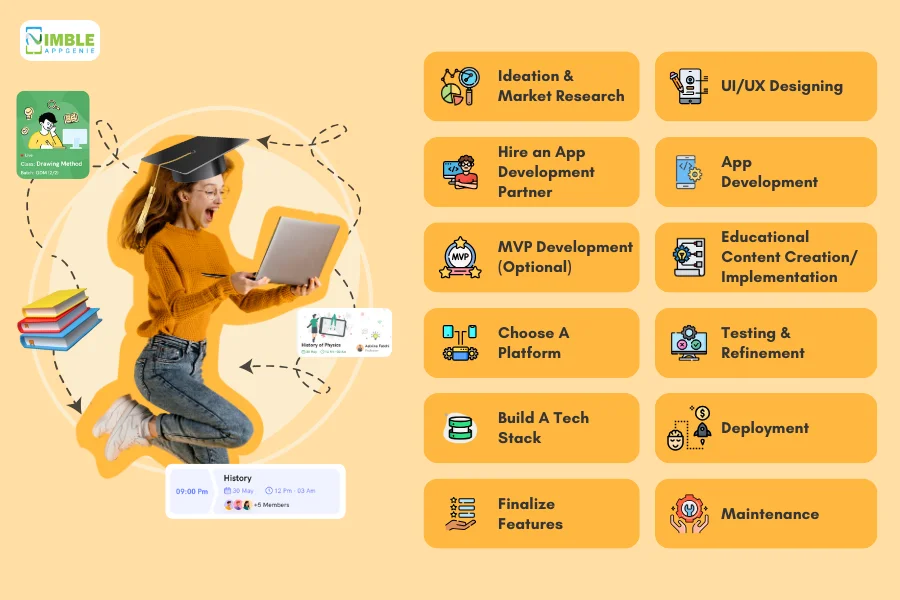
Therefore, with this being said, let’s get right into it, starting with:
Step 1: Ideation & Market Research
The first step in creating a successful educational app is ideation and market research.
First, you need an idea.
Thankfully, there are numerous educational app ideas.
Once you have it, then it’s time to start defining the concept of your app based on educational needs and potential gaps in the current market.
Conduct thorough market research to understand your target audience, including students, educators, or professionals, and identify what type of educational content or functionality they seek but currently lack.
Analyzing competitors is crucial; identify their strengths and weaknesses to find your unique angle.
Using tools like Google Trends or educational forums can provide insights into trending educational topics or features.
Step 2: Hire an App Development Partner
It’s time to hire app developers.
For many businesses, especially those without in-house technical expertise, hiring an app development partner is a strategic move.
Focus on finding a partner with experience in developing eLearning apps.
While it’s important to collaborate with a team that understands the nuances of educational technology, subtly emphasize the benefits of outsourcing without making it overly apparent.
Look for a partner with a portfolio of successful educational apps to consider their approach to user engagement and educational outcomes.
Step 3: MVP Development (Optional)
Minimum Viable Product (MVP) development is an optional but often recommended step.
An MVP allows you to launch a product with enough features to satisfy early users and provide valuable feedback for future development cycles.
This approach is cost-effective and less risky, enabling you to test the waters with your core functionalities and gauge user acceptance before committing to more extensive features.
Not to mention, gathering enough confidence, it also makes it a lot easier to get app funding.
Step 4: Choose A Platform
One of the most important steps of a mobile eLearning app development guide is choosing the platform.
Choosing the right platform is critical to reaching your intended audience effectively.
Here are the main options:
- Android App Development: Opt for this if you aim to reach a broader audience, particularly in developing countries where Android holds a significant market share.
- iOS App Development: Choose iOS if your target demographic is in regions with higher iOS usage, like the U.S. or Western Europe. iOS users also tend to spend more on apps, which could be beneficial if you plan to monetize your app.
- Hybrid App Development: This is suitable if you want to cover both Android and iOS with a single codebase. While it can be more cost-effective and faster to develop, performance and access to native features might be limited compared to native apps.
And once you are done with this, it’s time to go for a tech stack.
Step 5: Build A Tech Stack
Selecting the right technology stack is crucial for building a robust, scalable, and maintainable educational app.
Here’s a detailed breakdown:
| Layer | Technologies | Purpose |
| Front-end | React, Angular, Vue.js | To create dynamic and responsive user interfaces. Swift for iOS and Kotlin for Android are used for native mobile app development. |
| Back-end | Node.js, Python (Django, Flask), Ruby on Rails | To manage server-side logic, database operations, and application integration. |
| Database | PostgreSQL, MongoDB, Firebase | To store, retrieve, and manage app data efficiently. The choice depends on scalability needs and data structure. |
| Cloud Services | AWS, Azure, Google Cloud | To leverage cloud computing for hosting, storage, and scalable computing resources. |
| DevOps Tools | Docker, Jenkins, Kubernetes | To automate software deployment processes, ensuring efficient release and deployment cycles. |
| Testing Tools | Jest, XCTest, Espresso | To ensure the app functions correctly across all scenarios and platforms. |
Each component of your tech stack must be chosen based on the specific needs of the educational app, such as user load, real-time data processing, and integration requirements.
Step 6: Finalize Features
Features can make an app or break an app.
And when you want to develop an educational app that will revolutionize the market, it becomes that much more important.
Deciding on the core and advanced features of your app involves balancing user needs with practical development constraints.
Here’s a more detailed view:
Essential Features Table:
| Features | Description |
| 1. User Registration/Login | A secure mechanism for users to create and access their accounts. Includes authentication methods like OAuth, email/password, and social media logins. |
| 2. Course Management | Tools for administrators to upload, update, and manage courses. Should include features like categorization, tagging, and search capabilities. |
| 3. Interactive Quizzes | Dynamic testing tools that allow for the creation of quizzes with various question types, scoring systems, and instant feedback. |
| 4. Multimedia Support | Support for embedding or streaming video and audio content, including integration with third-party platforms like YouTube or Vimeo. |
| 5. Live Interaction Capabilities | Features such as live chat, forums, and video conferencing to facilitate real-time communication between educators and learners. |
| 6. Push Notifications | Timely notifications about course updates, new content, exams, and interactive sessions to keep users engaged. |
Also Read: Online Learning Solution Features
Advanced Features List:
- AI-driven Personalization: Algorithms that adapt content and recommendations based on individual learning patterns and preferences.
- Virtual and Augmented Reality: Integration of VR and AR for immersive learning experiences in subjects like science, history, and languages.
- Blockchain for Certification: Use of blockchain technology to issue verifiable and tamper-proof educational certificates.
- Advanced Analytics Dashboard: Tools for educators and administrators to track engagement, progress, and outcomes to optimize content and teaching strategies.
- Social Media Integration: Allowing users to share achievements and progress on social platforms, fostering community and engagement.
Step 7: UI/UX Designing
In the UI/UX design phase, the goal is to create an engaging yet straightforward interface that enhances user learning experiences.
The design should prioritize navigational ease, with clear menus and intuitive controls that are accessible to all user groups. Visual elements need to be appealing but not overwhelming, facilitating concentration and learning.
The user experience should be seamless, with fast-loading pages and minimal disruptions.
Feedback mechanisms should be integrated to capture user experiences in real-time, allowing for iterative improvements based on actual user interactions.
Also Read: App Development Checklist
Step 8: App Development
It’s time to build eLearning app.
App development is the execution phase where design and features come to life.
This process involves both front-end and back-end development tasks. The front-end focuses on user interface components and interactions, while the back-end handles data management, server-side logic, and integration with other systems.
It’s important during this phase to adhere to coding best practices to ensure the app is secure, scalable, and maintainable.
Regular code review and performance testing should be integral to the development process to catch and resolve issues early.
Step 9: Educational Content Creation/Implementation
Content is at the heart of any educational app.
High-quality, engaging educational material must be developed, which could range from textual content and infographics to interactive modules and video tutorials.
The content should be structured to cater to different learning styles and levels, ensuring inclusivity.
Implementing content effectively requires a robust content management system (CMS) that allows for easy updates and management by educators and administrators.
Creating educational content is an important part of building eLearning app.
Step 10: Testing & Refinement
App Testing is critical to ensuring the app meets quality standards and user expectations.
This phase involves multiple types of tests including functional, performance, security, and user acceptance testing (UAT).
Each test is designed to ensure that the app is not only bug-free but also user-friendly and capable of handling real-world usage scenarios.
And once this is done, it’s time for deployment.
Step 11: Deployment
Deployment is the final step in making the app available to users.
This involves setting up the app on production servers and publishing it to app stores such as Google Play for Android and the App Store for iOS.
This phase may also include the setup of monitoring tools to track app performance and user behavior in real-time.
This is crucial for ongoing maintenance and updates.
Step 12: Maintenance
The work doesn’t end when you create an eLearning app, there’s more.
Post-deployment, the app will require ongoing app maintenance to ensure it continues to function smoothly as technology and user expectations evolve.
This includes regular updates to add new features, improve existing ones, and fix bugs.
Monitoring user interactions and gathering feedback are important for identifying areas for enhancement.
Regular performance evaluations are necessary to ensure the app remains compatible with new operating systems and hardware.
How Much Does it Cost to Develop an eLearning App?
It’s time to talk about the cost.
A question that’s asked more times than “how to create an eLearning app?” is:
How much does it cost to build an eLearning app?
The average estimated cost to build an educational app can be $25,000 to $350,000. This depends on various factors like platform, features, size, complexity, and so on.
| Step | Features | Cost Range |
| 1. Initial Development | UI/UX Design, Content Management, User Authentication, Learning Content | $5K – $100K |
| 2. Enhancement and Engagement | Gamification, Progress Tracking, and Communication Tools | $5K – $50K |
| 3. Platform and Integration | Platform Support and API Integration | $10K – $80K |
| 4. Quality Assurance | Testing & QA, Maintenance & Updates | $5K – $70K |
eLearning App Development Challenges
Mobile app development isn’t paved path, let alone a complex project like developing an eLearning app.
So, a big part of the Online Learning App Development Guide is learning about common development mistakes and challenges that you might face during your journey.
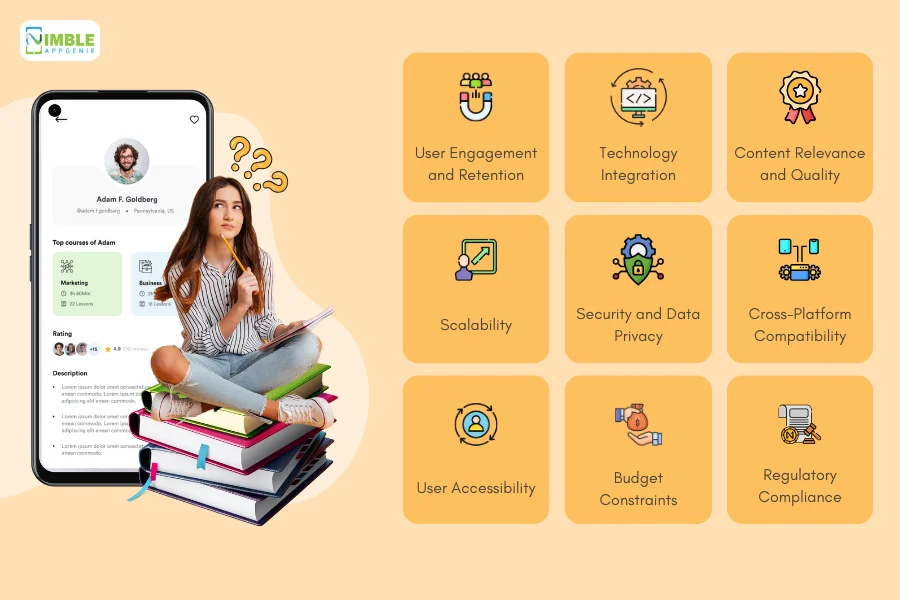
In this section, we shall be doing just that:
A] User Engagement and Retention
Engaging users and maintaining their interest over time is one of the biggest challenges. Educational apps need to be both informative and captivating to keep users coming back.
Integrating interactive elements, gamification, and personalized learning experiences can help increase engagement and prevent churn.
B] Technology Integration
Seamlessly integrating various technologies to create a cohesive learning experience can be complex.
This includes combining advanced technologies like virtual reality, augmented reality, and AI in elearning apps, with traditional app components.
Therefore, ensuring these technologies work together without issues requires careful planning and testing.
C] Content Relevance and Quality
Delivering high-quality, relevant content consistently is critical.
The content must be up-to-date, accurate, and aligned with educational standards and user expectations.
Regular updates and revisions by subject matter experts are necessary to maintain content quality and relevance.
Also Read: Mobile App Architecture Guide
D] Scalability
As the user base grows, the app needs to handle increased traffic and data without performance dips.
Planning for scalability from the outset—using scalable cloud services and optimizing the database and server architecture—is essential for supporting a growing number of users.
E] Security and Data Privacy
One of the biggest challenges when developing an edtech solution is app security.
Protecting user data and ensuring privacy are paramount, especially when dealing with children or sensitive educational information.
Implementing robust security measures, such as data encryption and secure authentication protocols, is crucial to safeguard user information and comply with regulations like GDPR and COPPA.
F] Cross-Platform Compatibility
Developing an educational app that provides consistent experience across various devices and operating systems can be challenging.
Cross-platform development tools can help, but they may also lead to compromises in app performance and user experience.
Thorough testing on multiple platforms is essential to ensure functionality and usability.
G] User Accessibility
Making the app accessible to all users, including those with disabilities, is not only a legal and moral requirement but also expands the app’s user base.
Accessibility features like screen reader support, text-to-speech, and customizable user interfaces are important considerations during the design and development phases.
H] Budget Constraints
It goes without saying app development cost can rise fast.
Funding for the development and ongoing maintenance of an educational app can be challenging, especially for startups or non-profit initiatives.
Proper budget planning and seeking funding through investors, grants, or partnerships can help manage financial constraints.
I] Regulatory Compliance
Lastly, one of the biggest challenges in developing an app for education is compliance. Navigating the complex landscape of educational regulations and standards can be daunting.
Compliance with local and international educational laws and standards must be a priority throughout the development and deployment phases to avoid legal issues and ensure the app is allowed in schools and educational institutions.
Each of these challenges requires careful consideration and strategic planning to overcome.
By addressing these issues head-on, developers can enhance the quality, reach, and impact of their educational applications, ensuring they provide valuable learning experiences to users.
Trends in Edtech to Look Out For
It’s time to look at edtech trends.
The landscape of educational technology is continually evolving, with new trends emerging that transform how information is delivered and consumed.
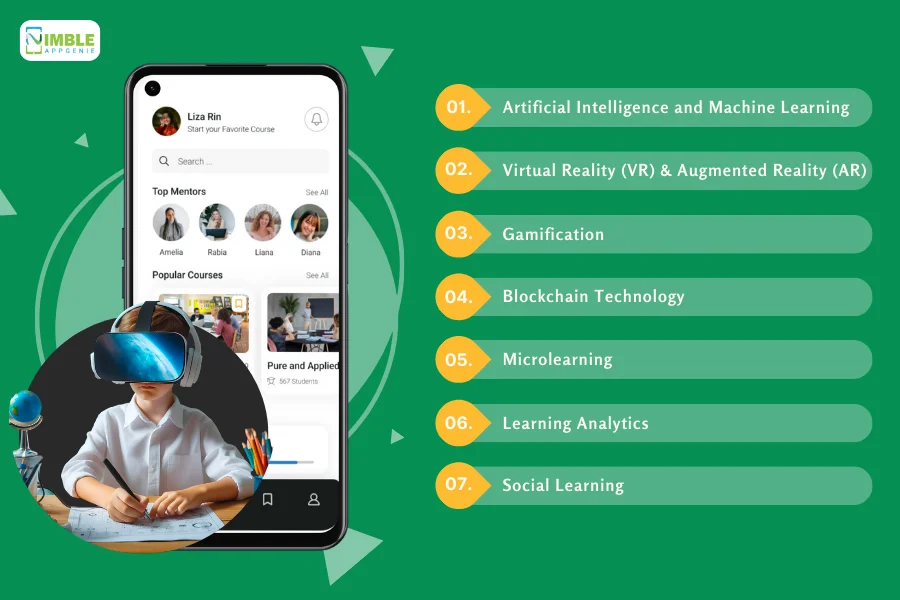
Here are some key trends in EdTech that stakeholders should watch out for, as they shape the future of education:
1. Artificial Intelligence and Machine Learning
AI app development is on the rise.
AI and machine learning are increasingly being integrated into educational platforms to provide personalized learning experiences.
These technologies analyze user data to adapt and customize content to fit individual learning paces, preferences, and challenges.
AI can also automate administrative tasks like grading and feedback, freeing up educators to focus more on teaching.
2. Virtual Reality (VR) and Augmented Reality (AR)
Following the VR and AR trends, it’s high time to implement that in edtech apps.
VR and AR are set to revolutionize the educational landscape by providing immersive learning experiences.
VR transports students to virtual worlds where they can interact with their surroundings, making learning more engaging. On the hand AR overlays digital information onto the real world, enhancing learning with interactive, three-dimensional objects students can explore up close.
3. Gamification
Incorporating game elements into education boosts engagement and motivation by making learning fun and competitive.
Gamification includes features like points, leaderboards, and badges that reward students for achieving their learning goals, effectively increasing student participation and retention rates.
4. Blockchain Technology
Blockchain development offers a secure way to issue and verify educational credentials, reduce fraud and make it easier to manage records transparently.
It also enables lifelong learning passports, which track an individual’s learning journey across different institutions and platforms.
5. Microlearning
This trend involves breaking down information into small, manageable units, making learning more digestible and easier to fit into busy schedules.
Microlearning is particularly effective for mobile learning, as short lessons can be completed on-the-go, catering to the modern learner’s lifestyle.
6. Learning Analytics
Learning analytics uses data analysis tools to assess educational processes and improve them.
These insights help educators personalize learning experiences and identify areas where students struggle, enhancing educational outcomes.
If you want to develop an eLearning app for next-gen, this is a must consider.
7. Social Learning
Social learning emphasizes collaboration and learning through social interaction.
Platforms incorporating social learning tools facilitate discussions, group projects, and peer feedback, mimicking a traditional classroom’s social aspects online.
So, these are the trends to consider if you want to know How to make an educational app that’s the next best thing.
And with this out of the way, it’s time to look at how you can make money with this solution.
How to Make Money With eLearning Platform?
It’s time to talk about app monetization.
eLearning app statistics does well to show the immense money waiting to be collected.
Creating a profitable eLearning platform involves multiple revenue streams that can be leveraged depending on your target audience, content quality, and user engagement strategies.
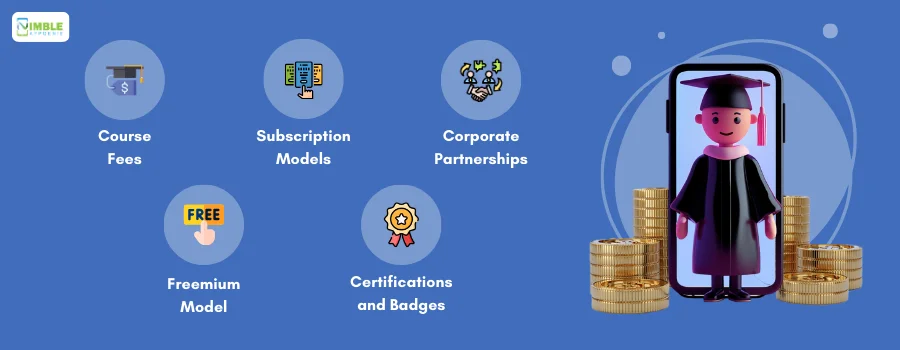
Here’s how to create an education app and make money with it:
Course Fees
For platforms offering specialized courses, particularly those providing professional training or certifications, charging per course is an effective monetization strategy.
Users pay a one-time fee for access to a course, which can vary in price based on the course’s comprehensiveness, exclusivity, or accreditation.
Platforms can charge anywhere from $20 for basic courses to several hundred dollars for advanced or accredited courses.
This model works well when you offer unique or high-demand content that users perceive as valuable.
Subscription Models
One of the most common revenue models for eLearning platforms is the subscription model.
In subscription based apps, users pay a recurring fee to access your courses and materials.
This model provides a steady income stream and can be tiered to offer different levels of access or content, catering to various needs and budgets.
For instance, platforms like Coursera or Udemy report average revenues of $50-$100 per user per year through tiered subscription services.
You can offer various tiers (e.g., basic, premium, and professional) to cater to different user needs and maximize revenue.
Corporate Partnerships
Partnering with businesses to provide tailored educational programs or training modules can open up lucrative opportunities.
Companies are often willing to pay for customized, high-quality training solutions that are directly aligned with their goals and needs.
By providing tailored training solutions to businesses, you can secure larger, more stable contracts that not only increase revenue but also improve platform credibility and reach.
Freemium Model
Let us introduce you to one of the best educational app business models, the freemium model.
So, what makes it one of the best in the market and something that every other platform uses? Well, for starters, this allows users to access basic content or features for free, while premium content requires payment.
This model can attract a large user base and convert a portion of those users to paying customers, particularly if the premium content significantly enhances the value of the free offerings.
Certifications and Badges
Offering certification or completion badges that users can add to their resumes or LinkedIn profiles can be an attractive feature.
You can charge a fee for the certification exams or for issuing official certificates.
They are valued by professionals looking to enhance their credentials.
Users might pay anywhere from $50 to $300 for certification exams or credentials, particularly if these are recognized in their professional fields.
This not only boosts platform revenue but also enhances user engagement and success stories, promoting further growth.
Choosing the Right Monetization Strategies
When selecting which revenue streams to pursue, consider the following factors to optimize your approach:
- Market Demand: Assess market trends and user willingness to pay, focusing on the most lucrative opportunities such as subscription models or specialized courses.
- Target Audience: Align monetization strategies with the preferences and needs of your primary audience, whether corporate clients or individual learners.
- Content Uniqueness and Quality: Leverage unique or high-quality content through direct sales, licensing, or premium subscriptions to maximize revenue.
- Scalability: Opt for scalable revenue models like subscriptions or certifications that grow easily with minimal additional costs per new user.
- Long-Term Value: Prioritize strategies that enhance the platform’s long-term sustainability and brand reputation, avoiding quick fixes like intrusive advertising.
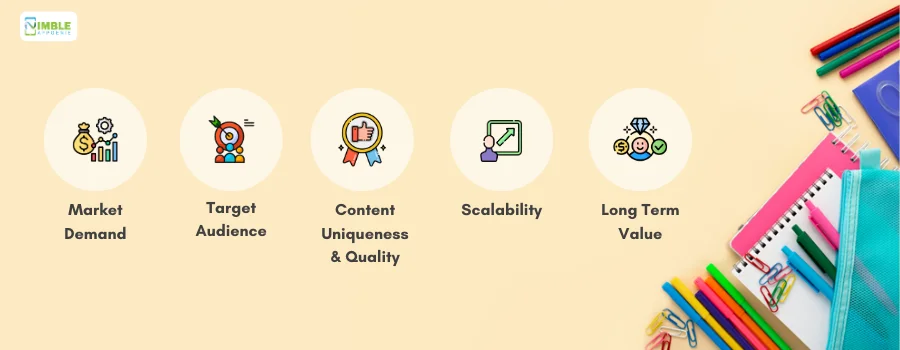
Nimble AppGenie: Converting Ideas into EdTech Excellence
That’s how you create an eLearning app.
Too much work? Well, we can handle it all for you.
We handle your unique idea with care an nurture it into a strong and market disrupting edtech app.
Nimble AppGenie has been in this business as the best educational app development company for a long time.
We have developed some of the best edtech apps, being the development force behind many great startups. That’s how we have earned 98% client satisfaction, completing more than 350 projects.
If you want to be the next best, we are here to help you.
Conclusion
As the digital education landscape continues to evolve, the opportunities for developing impactful eLearning applications are vast and varied.
By embracing innovative monetization strategies, integrating cutting-edge technologies, and navigating development challenges effectively, startups and businesses can significantly influence educational outcomes.
Whether through personalized learning experiences, immersive technologies, or scalable solutions, the potential to transform traditional educational methods is immense.
Harnessing these opportunities requires careful planning, a deep understanding of market needs, and a commitment to delivering quality educational content, ultimately paving the way for a more informed and skilled global population.
FAQs
- What exactly is an eLearning app, and how does it differ from traditional education methods?
An eLearning app is a digital platform that facilitates learning through interactive content accessible via smartphones, tablets, or computers. Unlike traditional methods, eLearning apps offer flexibility, personalization, and accessibility, allowing users to learn at their own pace and convenience.
- What are some effective ways to monetize an eLearning platform?
Monetization strategies for eLearning platforms include subscription models, course fees, corporate partnerships, licensing content, certifications or badges, advertising and sponsorships, affiliate marketing, selling educational products, donations, and crowdfunding.
- What are the emerging trends in educational technology (EdTech) that eLearning platforms should embrace?
Key trends in EdTech include artificial intelligence and machine learning, virtual and augmented reality, gamification, blockchain technology, microlearning, learning analytics, mobile-first design, Internet of Things (IoT), and social learning.
- What are some common challenges faced during eLearning app development and how can they be addressed?
eLearning app development challenges include user engagement and retention, technology integration, content quality, scalability, security and privacy, cross-platform compatibility, user accessibility, budget constraints, and regulatory compliance.
- How can I choose the right monetization strategies for my eLearning platform?
Considerations for choosing monetization strategies include market demand, target audience preferences, content uniqueness and quality, scalability, and long-term value. Aligning these factors with your business goals will help you select the most effective revenue streams.
- Can eLearning apps be used for corporate training, and if so, how effective are they?
Yes, eLearning apps are widely used for corporate training due to their flexibility, scalability, and cost-effectiveness. They offer employees the opportunity to access training materials anytime, anywhere, leading to improved learning outcomes and employee performance.
- What are some examples of successful eLearning platforms, and what sets them apart from others?
Examples of successful eLearning platforms include Coursera, Udemy, Khan Academy, LinkedIn Learning, and Skillshare. These platforms stand out for their diverse course offerings, high-quality content, user-friendly interfaces, and innovative features.
- How can eLearning platforms ensure the security and privacy of user data?
eLearning platforms can ensure the security and privacy of user data by implementing robust security measures such as data encryption, secure authentication protocols, regular security audits, compliance with regulations like GDPR and COPPA, and transparent privacy policies.
- What role does user engagement play in the success of an eLearning platform, and how can it be enhanced?
User engagement is crucial for the success of an eLearning platform as it directly impacts user retention and satisfaction. Engagement can be enhanced through personalized learning experiences, interactive content, gamification elements, community features, and timely feedback mechanisms.
- How can eLearning platforms stay relevant and competitive in a rapidly evolving market?
eLearning platforms can stay relevant and competitive by continuously innovating and adapting to emerging trends, listening to user feedback, expanding their course offerings, collaborating with industry partners, investing in technology infrastructure, and providing exceptional customer support.

Niketan Sharma is the CTO of Nimble AppGenie, a prominent website and mobile app development company in the USA that is delivering excellence with a commitment to boosting business growth & maximizing customer satisfaction. He is a highly motivated individual who helps SMEs and startups grow in this dynamic market with the latest technology and innovation.
Table of Contents




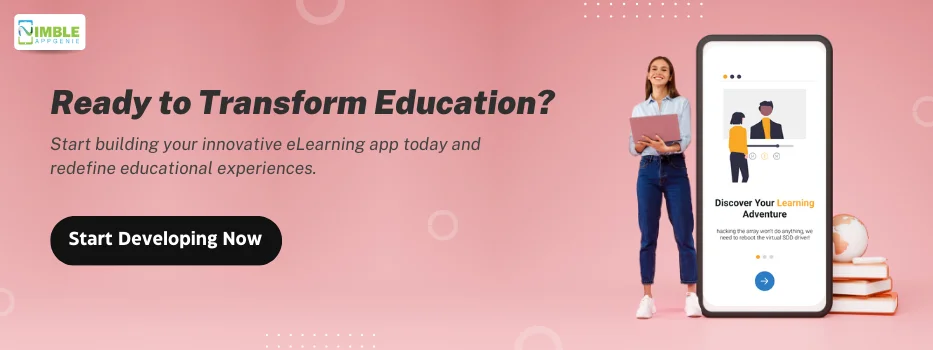
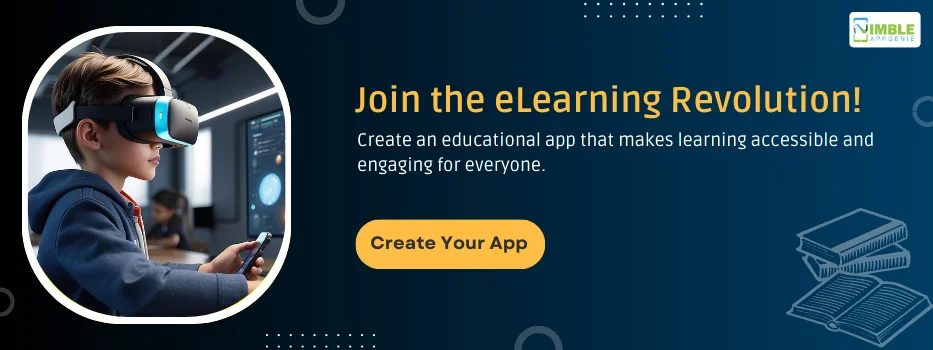
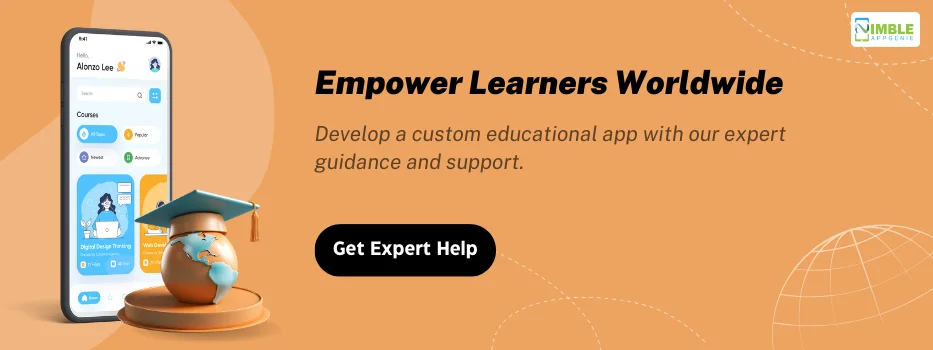








No Comments
Comments are closed.